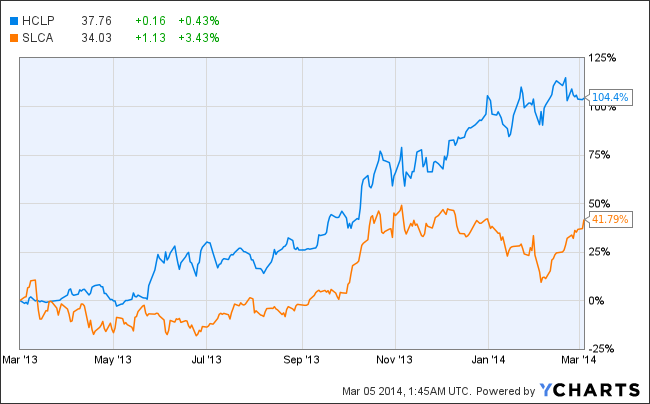Which Proppant Company is Right for You?
Hydraulic fracturing, coupled with horizontal drilling, propels the US toward energy independence. Investing in companies searching for oil carries wonderful profit potential and significant risk. Since all companies using hydraulic fracturing need proppants, investing in proppant suppliers might offer a safer alternative. Hi-Crush Partners and US Silica are two similar sized companies in the proppants business. As the chart below shows, both have done well over the past year, Hi-Crush particularly. Which company should you invest in?
A master limited partnership built on sand
Northern White sand offers oil drillers a cheap domestic proppant for their operations, and Hi-Crush owns a big pile of it. Thirty three years' worth, in fact. The sand comes in all sizes, and Hi-Crush supplies it to every major shale play in the US. In fact, Hi-Crush claims to be the biggest supplier of proppants to the Utica and Marcellus shale plays.
Beyond just digging sand out of the ground and sending it on its way, Hi-Crush provides a variety of logistics services to its customers. Particularly, following the acquisition of D and I Silica, LLC, Hi-Crush operates a dozen distribution terminals in the Utica and Marcellus shale plays. This means sand travels by rail to these distribution terminals from which customers pick it up. The company claims no customer travels more than 75 miles to reach one of its distribution terminals. Hi-Crush is building another distribution terminal to serve the market in the Permian Basin market in Texas.
One reason Hi-Crush stock has done well is that over the past year or so is that the production cost of sand dropped from $15.89 per ton to currently $12.50/ton. For example, during its fourth quarter conference call, Co-CEO Jim Whipkey mentioned reduced shipping costs to specific locations in Ohio by using Canadian National rather than Union Pacific railroad. Look for Hi-Crush to continue reducing its production expenses.
Proppants and more
While Hi-Crush does sand, US Silica does sand, resin-coated sand for hydraulic fracturing and silica for industrial applications. While its "Industrial and Specialty Products" division contributes to revenues, the big financial driver is the sale of proppants to the US energy industry.
Much like Hi-Crush, US Silica not only sells proppants; it also offers logistics services for its proppants. In fact, US Silica offers more distribution points, or transloads, than Hi-Crush. Most of these transloads are located in the major shale plays. US Silica also owns 3,600 railcars with plans to expand this fleet to 4,300 cars by the end of the year. In contrast, Hi-Crush owns no railcars, but does offer railcar management and storage services to its customers that do.
One expense US Silica bears that Hi-Crush doesn't is research. US Silica continues investing in silica and its industrial applications. If US Silica wishes to be competitive in the industrial world, and not just ship sand, this is an expense it must bear. For example, glass used for smartphones and other mobile devices will likely need to be lighter as mobile tech becomes "wearable" tech. The only way to do that is to invest time and money into people and laboratories focused on that challenge.
So, where to invest?
For investors seeking income, Hi-Crush beats US Silica hands down. Hi-Crush currently pays a distribution yield of around 5.4% compared to US Silica's yield of about 1.5%. US Silica has been a publicly traded company for about two years and hasn't increased its dividend in that time. Hi-Crush had its IPO after US Silica's, but has raised its distribution more than once. Reporting a distribution coverage ratio of 1.38x, Hi-Crush's distribution looks not only safe, but leaves the company with extra cash to spend on acquisitions, upgrades or other business needs.
For growth investors, Hi-Crush also offers a better track record of stock performance. Its revenues for the 2013 fiscal year were almost double that of 2012. Earnings per unit increased from $0.35 in the fourth quarter of 2012 to $0.63 in 2013. Annual earnings comparisons are not available due to the timing of Hi-Crush's IPO. In contrast, US Silica's annual revenues increased 23.6% from 2012 to 2013, but experienced a decline in earnings from $1.50 a share to $1.41 a share.
Final Foolish Thoughts
Both companies project increased proppant use in the future. A safe projection, as drillers drill longer and more densely spaced wells. So which company will do best for investors? All around, I'd have to say Hi-Crush makes the more compelling investment. The company is focused on one thing, moving sand, and does not have the research overhead that US Silica has. Hi-Crush revenues have grown faster than US Silica's, and Hi-Crush offers far more in income than US Silica. Even better, that income is supported by a coverage ratio of 1.38x, well above the 1.0x ratio deemed sustainable. While US Silica will undoubtedly grow with the US fracking industry, it seems to me Hi-Crush will return more to its investors.
The article Which Proppant Company is Right for You? originally appeared on Fool.com.
Robert Zimmerman has the following options: short April 2014 $35 puts on HI-CRUSH PARTNERS LP UNIT LTD PARTNER INTS. The Motley Fool has no position in any of the stocks mentioned. Try any of our Foolish newsletter services free for 30 days. We Fools may not all hold the same opinions, but we all believe that considering a diverse range of insights makes us better investors. The Motley Fool has a disclosure policy.
Copyright © 1995 - 2014 The Motley Fool, LLC. All rights reserved. The Motley Fool has a disclosure policy.


